Analysis of Leadership and Management in Waitrose Operations
VerifiedAdded on 2020/12/09
|16
|4954
|56
Report
AI Summary
This report provides a comprehensive analysis of leadership and management practices within Waitrose, a British supermarket chain. The introduction outlines the significance of operations management and introduces the focus on Waitrose. Task 1 delves into the distinctions between leaders and managers, examining their roles, characteristics, and responsibilities, with a comparison table illustrating key differences. It explores leadership theories like situational, system, and contingency leadership, illustrated through Waitrose's operational context. Task 2 investigates the roles of leaders and managers in operational management, including their functions in planning, organizing, commanding, coordinating, and controlling, according to Henry Fayol's principles. The report also analyzes the application of various leadership styles within Waitrose, considering its competitive environment and decision-making processes. The conclusion summarizes the key findings, highlighting the importance of effective leadership and management in achieving organizational objectives within the retail industry. The report uses Waitrose as a case study to illustrate the practical application of these concepts.
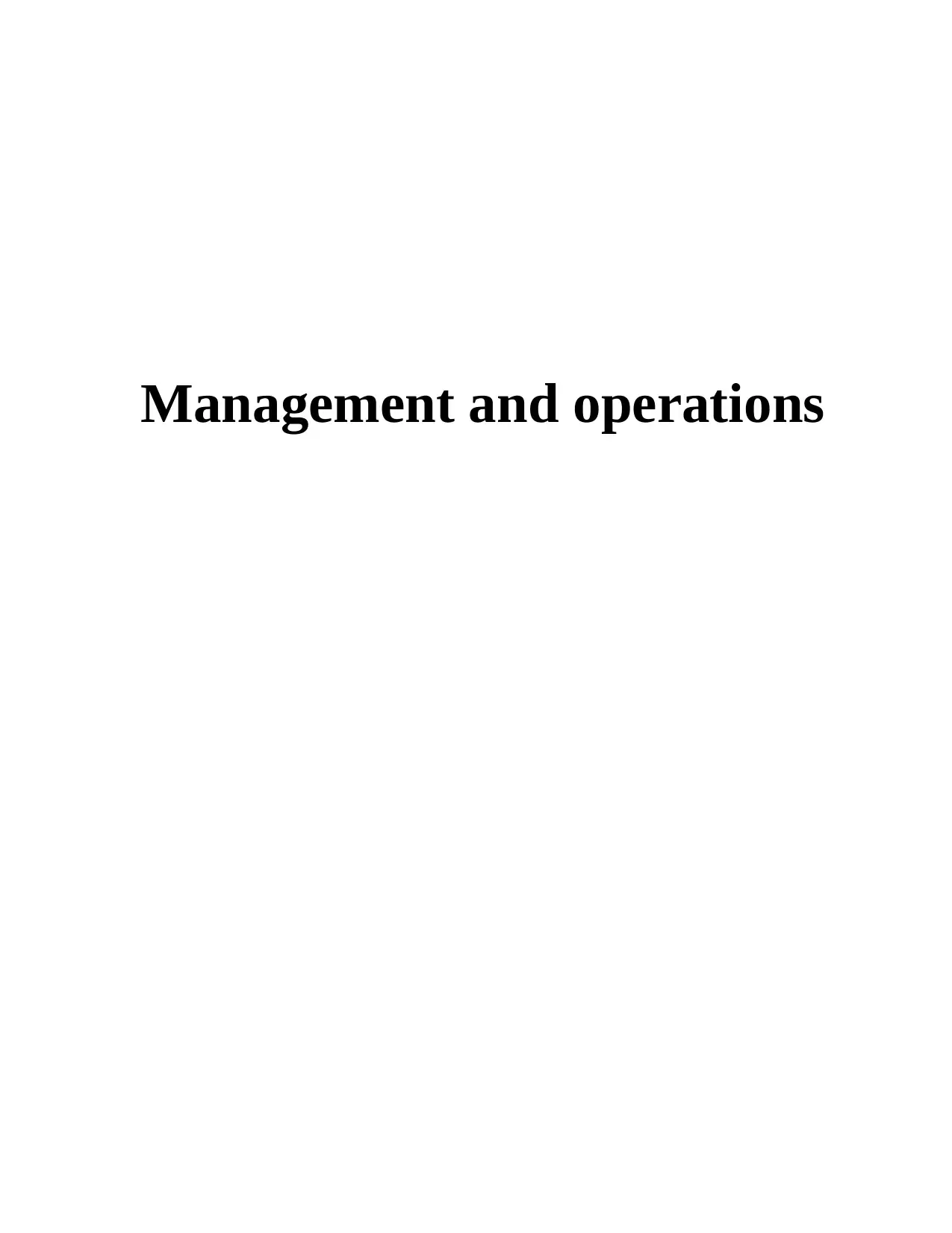
Management and operations
Paraphrase This Document
Need a fresh take? Get an instant paraphrase of this document with our AI Paraphraser
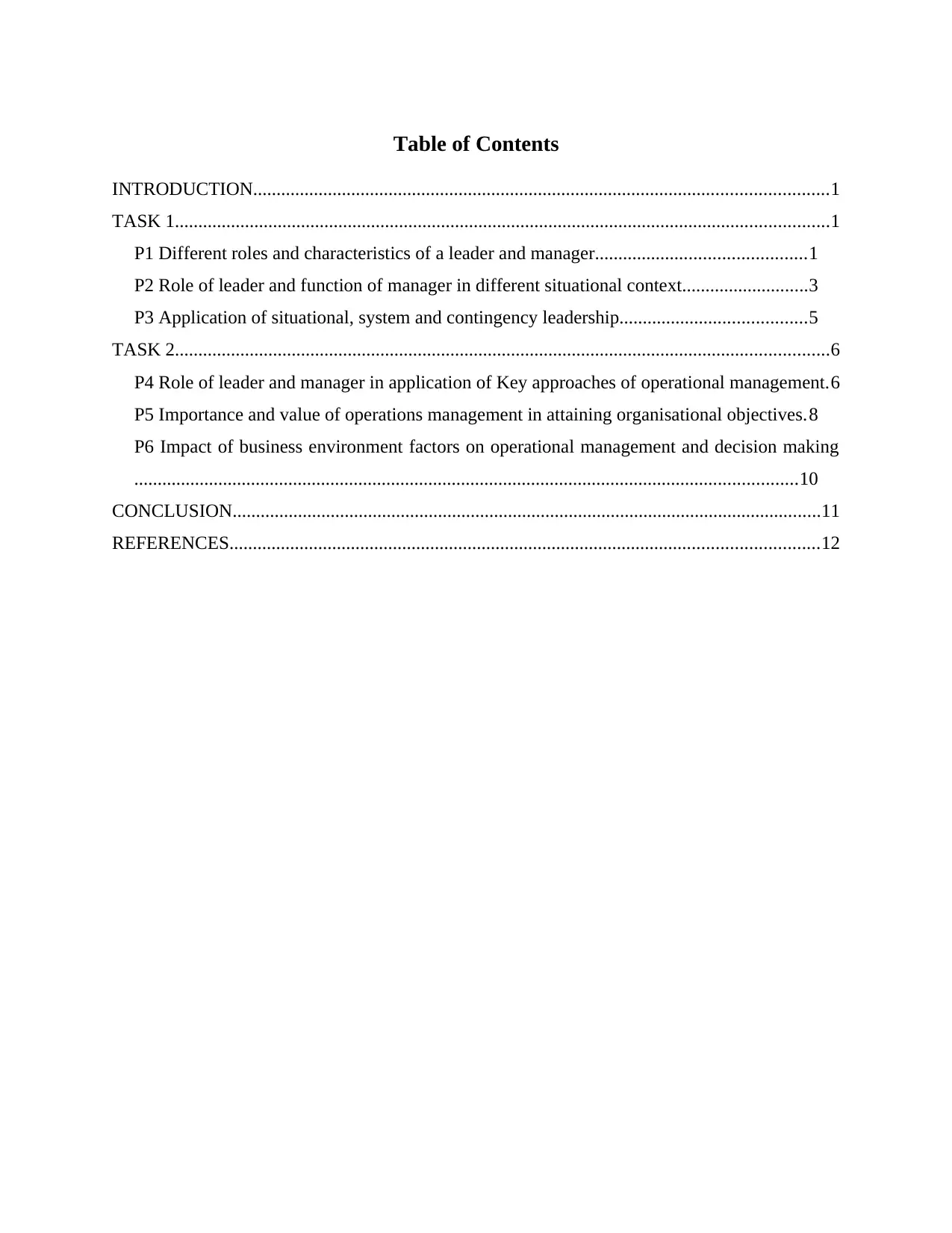
Table of Contents
INTRODUCTION...........................................................................................................................1
TASK 1............................................................................................................................................1
P1 Different roles and characteristics of a leader and manager.............................................1
P2 Role of leader and function of manager in different situational context...........................3
P3 Application of situational, system and contingency leadership........................................5
TASK 2............................................................................................................................................6
P4 Role of leader and manager in application of Key approaches of operational management.6
P5 Importance and value of operations management in attaining organisational objectives.8
P6 Impact of business environment factors on operational management and decision making
..............................................................................................................................................10
CONCLUSION..............................................................................................................................11
REFERENCES..............................................................................................................................12
INTRODUCTION...........................................................................................................................1
TASK 1............................................................................................................................................1
P1 Different roles and characteristics of a leader and manager.............................................1
P2 Role of leader and function of manager in different situational context...........................3
P3 Application of situational, system and contingency leadership........................................5
TASK 2............................................................................................................................................6
P4 Role of leader and manager in application of Key approaches of operational management.6
P5 Importance and value of operations management in attaining organisational objectives.8
P6 Impact of business environment factors on operational management and decision making
..............................................................................................................................................10
CONCLUSION..............................................................................................................................11
REFERENCES..............................................................................................................................12
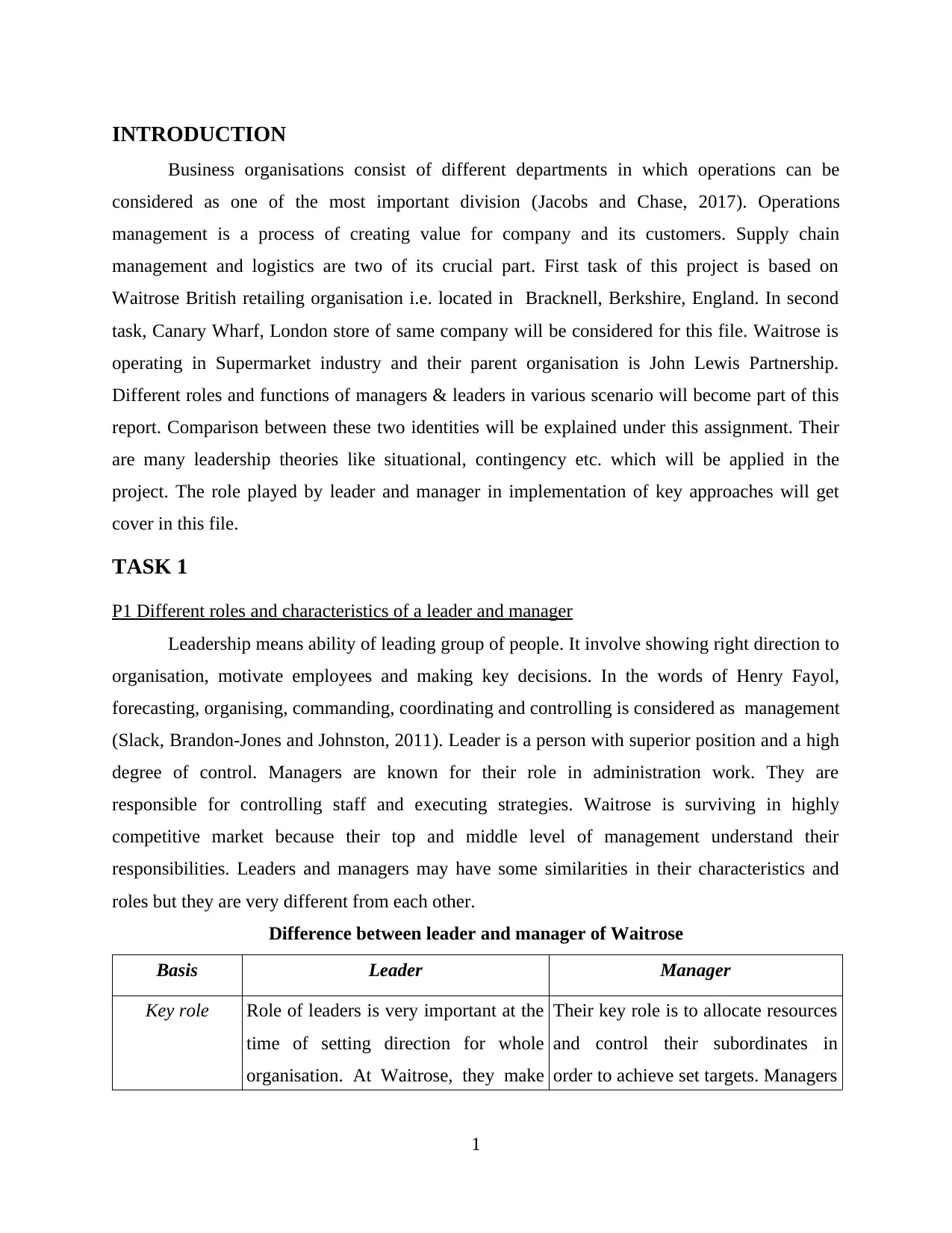
INTRODUCTION
Business organisations consist of different departments in which operations can be
considered as one of the most important division (Jacobs and Chase, 2017). Operations
management is a process of creating value for company and its customers. Supply chain
management and logistics are two of its crucial part. First task of this project is based on
Waitrose British retailing organisation i.e. located in Bracknell, Berkshire, England. In second
task, Canary Wharf, London store of same company will be considered for this file. Waitrose is
operating in Supermarket industry and their parent organisation is John Lewis Partnership.
Different roles and functions of managers & leaders in various scenario will become part of this
report. Comparison between these two identities will be explained under this assignment. Their
are many leadership theories like situational, contingency etc. which will be applied in the
project. The role played by leader and manager in implementation of key approaches will get
cover in this file.
TASK 1
P1 Different roles and characteristics of a leader and manager
Leadership means ability of leading group of people. It involve showing right direction to
organisation, motivate employees and making key decisions. In the words of Henry Fayol,
forecasting, organising, commanding, coordinating and controlling is considered as management
(Slack, Brandon-Jones and Johnston, 2011). Leader is a person with superior position and a high
degree of control. Managers are known for their role in administration work. They are
responsible for controlling staff and executing strategies. Waitrose is surviving in highly
competitive market because their top and middle level of management understand their
responsibilities. Leaders and managers may have some similarities in their characteristics and
roles but they are very different from each other.
Difference between leader and manager of Waitrose
Basis Leader Manager
Key role Role of leaders is very important at the
time of setting direction for whole
organisation. At Waitrose, they make
Their key role is to allocate resources
and control their subordinates in
order to achieve set targets. Managers
1
Business organisations consist of different departments in which operations can be
considered as one of the most important division (Jacobs and Chase, 2017). Operations
management is a process of creating value for company and its customers. Supply chain
management and logistics are two of its crucial part. First task of this project is based on
Waitrose British retailing organisation i.e. located in Bracknell, Berkshire, England. In second
task, Canary Wharf, London store of same company will be considered for this file. Waitrose is
operating in Supermarket industry and their parent organisation is John Lewis Partnership.
Different roles and functions of managers & leaders in various scenario will become part of this
report. Comparison between these two identities will be explained under this assignment. Their
are many leadership theories like situational, contingency etc. which will be applied in the
project. The role played by leader and manager in implementation of key approaches will get
cover in this file.
TASK 1
P1 Different roles and characteristics of a leader and manager
Leadership means ability of leading group of people. It involve showing right direction to
organisation, motivate employees and making key decisions. In the words of Henry Fayol,
forecasting, organising, commanding, coordinating and controlling is considered as management
(Slack, Brandon-Jones and Johnston, 2011). Leader is a person with superior position and a high
degree of control. Managers are known for their role in administration work. They are
responsible for controlling staff and executing strategies. Waitrose is surviving in highly
competitive market because their top and middle level of management understand their
responsibilities. Leaders and managers may have some similarities in their characteristics and
roles but they are very different from each other.
Difference between leader and manager of Waitrose
Basis Leader Manager
Key role Role of leaders is very important at the
time of setting direction for whole
organisation. At Waitrose, they make
Their key role is to allocate resources
and control their subordinates in
order to achieve set targets. Managers
1
⊘ This is a preview!⊘
Do you want full access?
Subscribe today to unlock all pages.

Trusted by 1+ million students worldwide
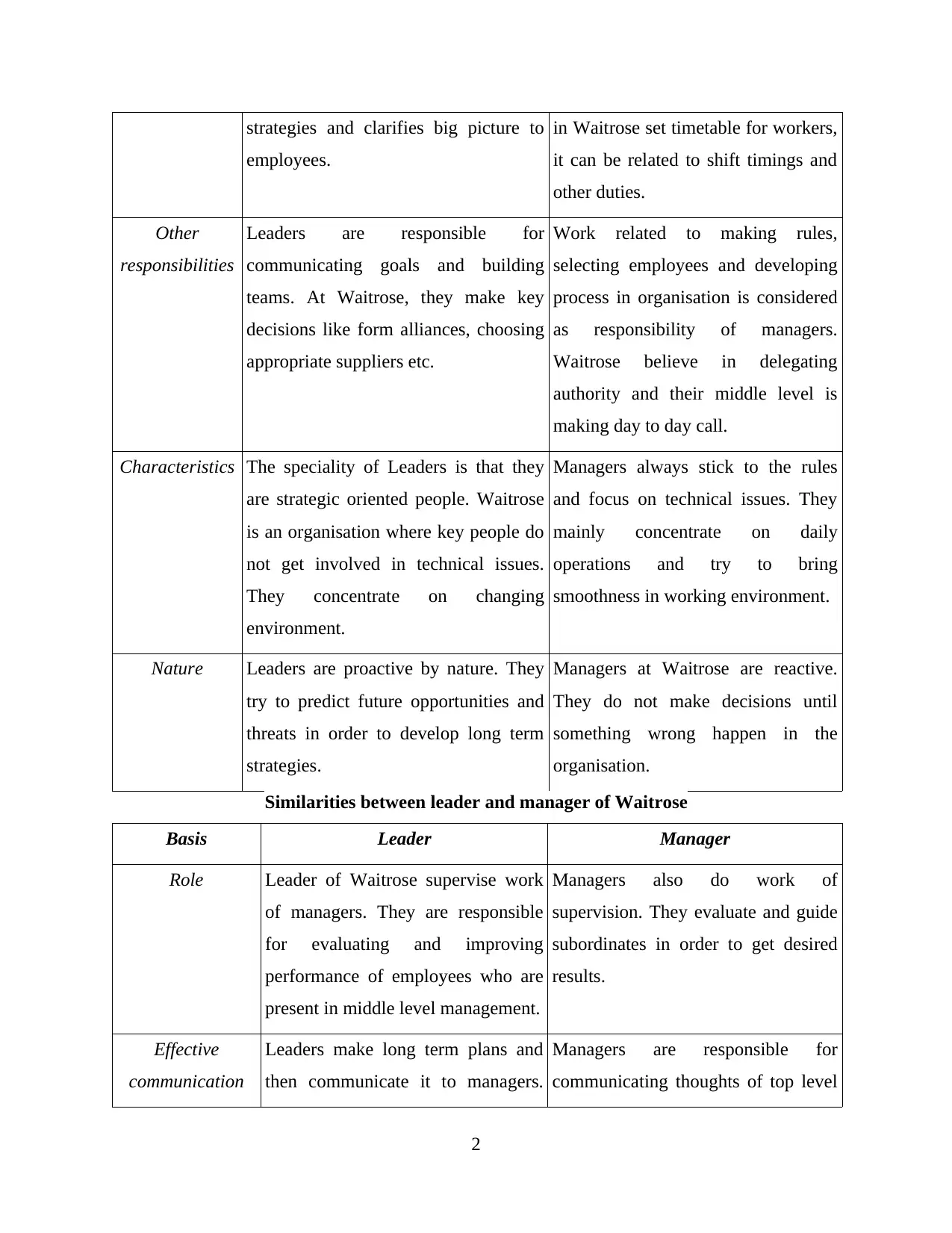
strategies and clarifies big picture to
employees.
in Waitrose set timetable for workers,
it can be related to shift timings and
other duties.
Other
responsibilities
Leaders are responsible for
communicating goals and building
teams. At Waitrose, they make key
decisions like form alliances, choosing
appropriate suppliers etc.
Work related to making rules,
selecting employees and developing
process in organisation is considered
as responsibility of managers.
Waitrose believe in delegating
authority and their middle level is
making day to day call.
Characteristics The speciality of Leaders is that they
are strategic oriented people. Waitrose
is an organisation where key people do
not get involved in technical issues.
They concentrate on changing
environment.
Managers always stick to the rules
and focus on technical issues. They
mainly concentrate on daily
operations and try to bring
smoothness in working environment.
Nature Leaders are proactive by nature. They
try to predict future opportunities and
threats in order to develop long term
strategies.
Managers at Waitrose are reactive.
They do not make decisions until
something wrong happen in the
organisation.
Similarities between leader and manager of Waitrose
Basis Leader Manager
Role Leader of Waitrose supervise work
of managers. They are responsible
for evaluating and improving
performance of employees who are
present in middle level management.
Managers also do work of
supervision. They evaluate and guide
subordinates in order to get desired
results.
Effective
communication
Leaders make long term plans and
then communicate it to managers.
Managers are responsible for
communicating thoughts of top level
2
employees.
in Waitrose set timetable for workers,
it can be related to shift timings and
other duties.
Other
responsibilities
Leaders are responsible for
communicating goals and building
teams. At Waitrose, they make key
decisions like form alliances, choosing
appropriate suppliers etc.
Work related to making rules,
selecting employees and developing
process in organisation is considered
as responsibility of managers.
Waitrose believe in delegating
authority and their middle level is
making day to day call.
Characteristics The speciality of Leaders is that they
are strategic oriented people. Waitrose
is an organisation where key people do
not get involved in technical issues.
They concentrate on changing
environment.
Managers always stick to the rules
and focus on technical issues. They
mainly concentrate on daily
operations and try to bring
smoothness in working environment.
Nature Leaders are proactive by nature. They
try to predict future opportunities and
threats in order to develop long term
strategies.
Managers at Waitrose are reactive.
They do not make decisions until
something wrong happen in the
organisation.
Similarities between leader and manager of Waitrose
Basis Leader Manager
Role Leader of Waitrose supervise work
of managers. They are responsible
for evaluating and improving
performance of employees who are
present in middle level management.
Managers also do work of
supervision. They evaluate and guide
subordinates in order to get desired
results.
Effective
communication
Leaders make long term plans and
then communicate it to managers.
Managers are responsible for
communicating thoughts of top level
2
Paraphrase This Document
Need a fresh take? Get an instant paraphrase of this document with our AI Paraphraser
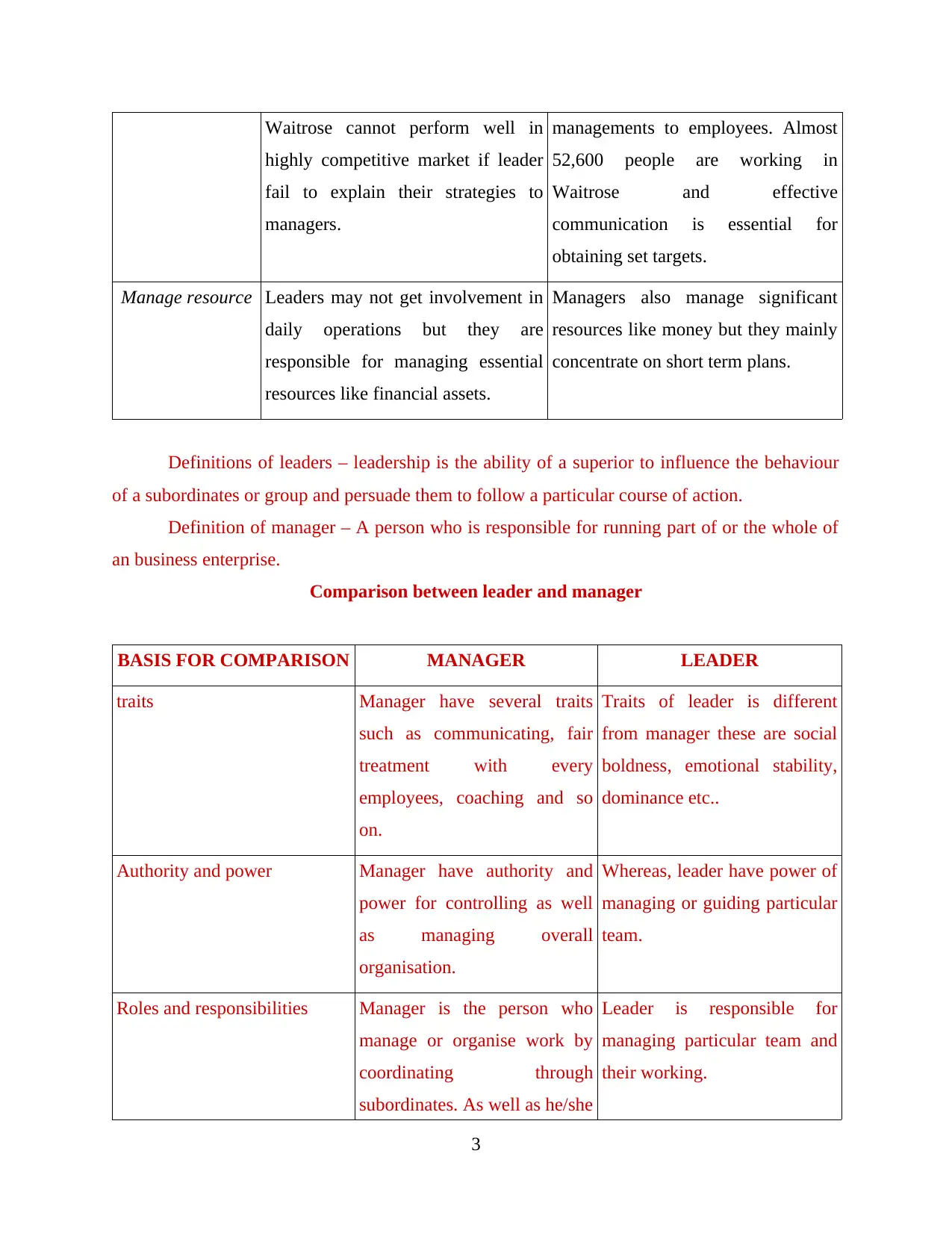
Waitrose cannot perform well in
highly competitive market if leader
fail to explain their strategies to
managers.
managements to employees. Almost
52,600 people are working in
Waitrose and effective
communication is essential for
obtaining set targets.
Manage resource Leaders may not get involvement in
daily operations but they are
responsible for managing essential
resources like financial assets.
Managers also manage significant
resources like money but they mainly
concentrate on short term plans.
Definitions of leaders – leadership is the ability of a superior to influence the behaviour
of a subordinates or group and persuade them to follow a particular course of action.
Definition of manager – A person who is responsible for running part of or the whole of
an business enterprise.
Comparison between leader and manager
BASIS FOR COMPARISON MANAGER LEADER
traits Manager have several traits
such as communicating, fair
treatment with every
employees, coaching and so
on.
Traits of leader is different
from manager these are social
boldness, emotional stability,
dominance etc..
Authority and power Manager have authority and
power for controlling as well
as managing overall
organisation.
Whereas, leader have power of
managing or guiding particular
team.
Roles and responsibilities Manager is the person who
manage or organise work by
coordinating through
subordinates. As well as he/she
Leader is responsible for
managing particular team and
their working.
3
highly competitive market if leader
fail to explain their strategies to
managers.
managements to employees. Almost
52,600 people are working in
Waitrose and effective
communication is essential for
obtaining set targets.
Manage resource Leaders may not get involvement in
daily operations but they are
responsible for managing essential
resources like financial assets.
Managers also manage significant
resources like money but they mainly
concentrate on short term plans.
Definitions of leaders – leadership is the ability of a superior to influence the behaviour
of a subordinates or group and persuade them to follow a particular course of action.
Definition of manager – A person who is responsible for running part of or the whole of
an business enterprise.
Comparison between leader and manager
BASIS FOR COMPARISON MANAGER LEADER
traits Manager have several traits
such as communicating, fair
treatment with every
employees, coaching and so
on.
Traits of leader is different
from manager these are social
boldness, emotional stability,
dominance etc..
Authority and power Manager have authority and
power for controlling as well
as managing overall
organisation.
Whereas, leader have power of
managing or guiding particular
team.
Roles and responsibilities Manager is the person who
manage or organise work by
coordinating through
subordinates. As well as he/she
Leader is responsible for
managing particular team and
their working.
3
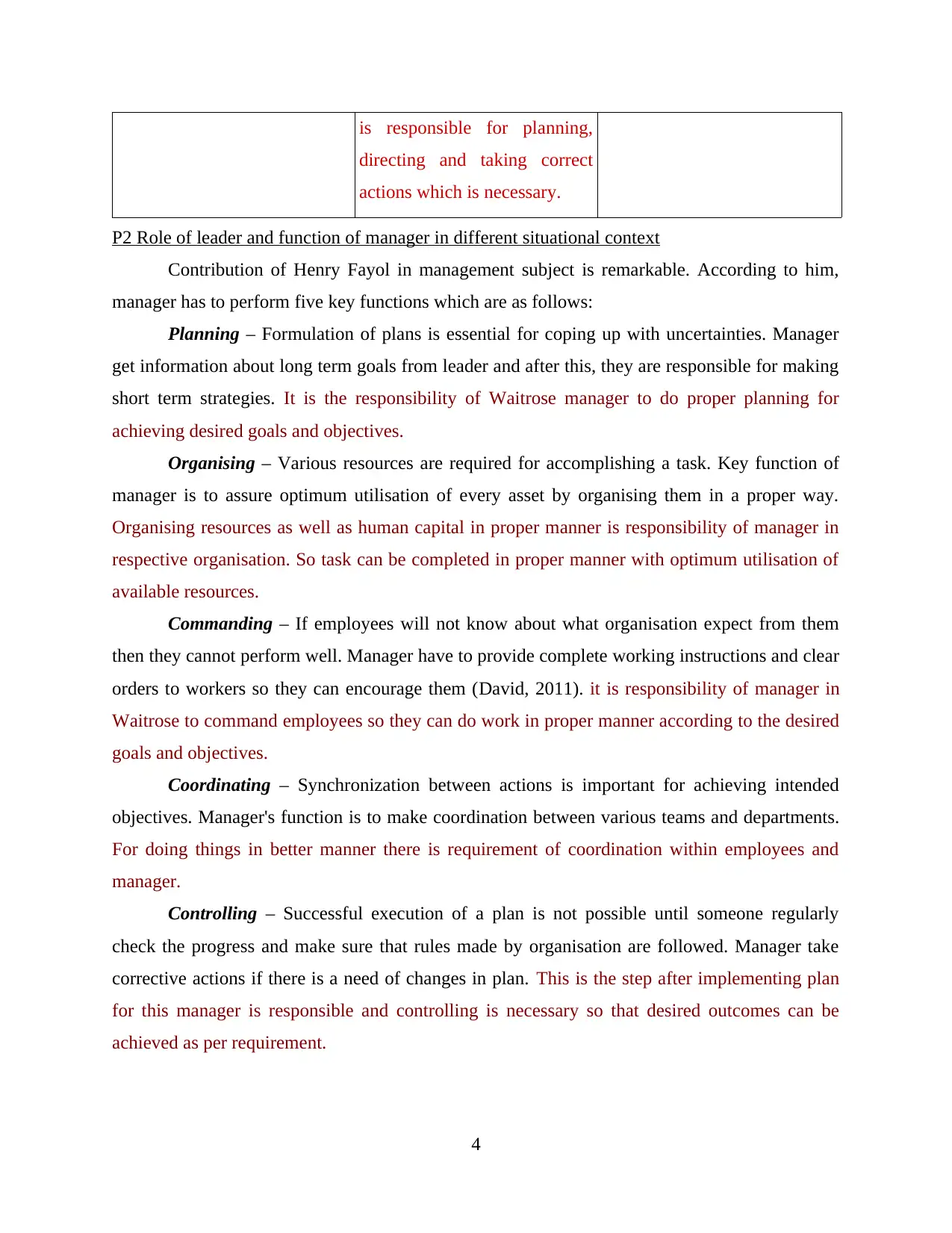
is responsible for planning,
directing and taking correct
actions which is necessary.
P2 Role of leader and function of manager in different situational context
Contribution of Henry Fayol in management subject is remarkable. According to him,
manager has to perform five key functions which are as follows:
Planning – Formulation of plans is essential for coping up with uncertainties. Manager
get information about long term goals from leader and after this, they are responsible for making
short term strategies. It is the responsibility of Waitrose manager to do proper planning for
achieving desired goals and objectives.
Organising – Various resources are required for accomplishing a task. Key function of
manager is to assure optimum utilisation of every asset by organising them in a proper way.
Organising resources as well as human capital in proper manner is responsibility of manager in
respective organisation. So task can be completed in proper manner with optimum utilisation of
available resources.
Commanding – If employees will not know about what organisation expect from them
then they cannot perform well. Manager have to provide complete working instructions and clear
orders to workers so they can encourage them (David, 2011). it is responsibility of manager in
Waitrose to command employees so they can do work in proper manner according to the desired
goals and objectives.
Coordinating – Synchronization between actions is important for achieving intended
objectives. Manager's function is to make coordination between various teams and departments.
For doing things in better manner there is requirement of coordination within employees and
manager.
Controlling – Successful execution of a plan is not possible until someone regularly
check the progress and make sure that rules made by organisation are followed. Manager take
corrective actions if there is a need of changes in plan. This is the step after implementing plan
for this manager is responsible and controlling is necessary so that desired outcomes can be
achieved as per requirement.
4
directing and taking correct
actions which is necessary.
P2 Role of leader and function of manager in different situational context
Contribution of Henry Fayol in management subject is remarkable. According to him,
manager has to perform five key functions which are as follows:
Planning – Formulation of plans is essential for coping up with uncertainties. Manager
get information about long term goals from leader and after this, they are responsible for making
short term strategies. It is the responsibility of Waitrose manager to do proper planning for
achieving desired goals and objectives.
Organising – Various resources are required for accomplishing a task. Key function of
manager is to assure optimum utilisation of every asset by organising them in a proper way.
Organising resources as well as human capital in proper manner is responsibility of manager in
respective organisation. So task can be completed in proper manner with optimum utilisation of
available resources.
Commanding – If employees will not know about what organisation expect from them
then they cannot perform well. Manager have to provide complete working instructions and clear
orders to workers so they can encourage them (David, 2011). it is responsibility of manager in
Waitrose to command employees so they can do work in proper manner according to the desired
goals and objectives.
Coordinating – Synchronization between actions is important for achieving intended
objectives. Manager's function is to make coordination between various teams and departments.
For doing things in better manner there is requirement of coordination within employees and
manager.
Controlling – Successful execution of a plan is not possible until someone regularly
check the progress and make sure that rules made by organisation are followed. Manager take
corrective actions if there is a need of changes in plan. This is the step after implementing plan
for this manager is responsible and controlling is necessary so that desired outcomes can be
achieved as per requirement.
4
⊘ This is a preview!⊘
Do you want full access?
Subscribe today to unlock all pages.

Trusted by 1+ million students worldwide
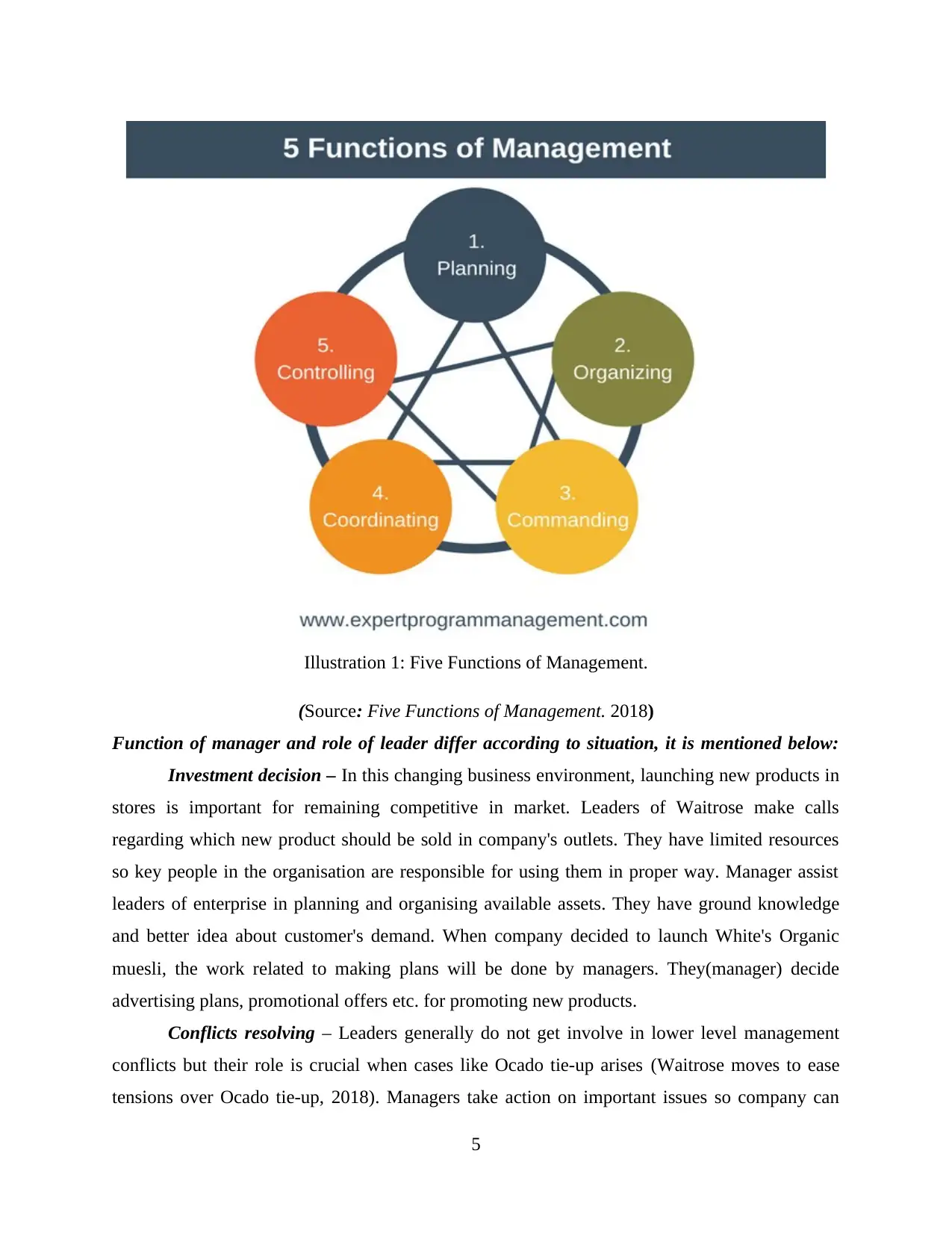
(Source: Five Functions of Management. 2018)
Function of manager and role of leader differ according to situation, it is mentioned below:
Investment decision – In this changing business environment, launching new products in
stores is important for remaining competitive in market. Leaders of Waitrose make calls
regarding which new product should be sold in company's outlets. They have limited resources
so key people in the organisation are responsible for using them in proper way. Manager assist
leaders of enterprise in planning and organising available assets. They have ground knowledge
and better idea about customer's demand. When company decided to launch White's Organic
muesli, the work related to making plans will be done by managers. They(manager) decide
advertising plans, promotional offers etc. for promoting new products.
Conflicts resolving – Leaders generally do not get involve in lower level management
conflicts but their role is crucial when cases like Ocado tie-up arises (Waitrose moves to ease
tensions over Ocado tie-up, 2018). Managers take action on important issues so company can
5
Illustration 1: Five Functions of Management.
Function of manager and role of leader differ according to situation, it is mentioned below:
Investment decision – In this changing business environment, launching new products in
stores is important for remaining competitive in market. Leaders of Waitrose make calls
regarding which new product should be sold in company's outlets. They have limited resources
so key people in the organisation are responsible for using them in proper way. Manager assist
leaders of enterprise in planning and organising available assets. They have ground knowledge
and better idea about customer's demand. When company decided to launch White's Organic
muesli, the work related to making plans will be done by managers. They(manager) decide
advertising plans, promotional offers etc. for promoting new products.
Conflicts resolving – Leaders generally do not get involve in lower level management
conflicts but their role is crucial when cases like Ocado tie-up arises (Waitrose moves to ease
tensions over Ocado tie-up, 2018). Managers take action on important issues so company can
5
Illustration 1: Five Functions of Management.
Paraphrase This Document
Need a fresh take? Get an instant paraphrase of this document with our AI Paraphraser
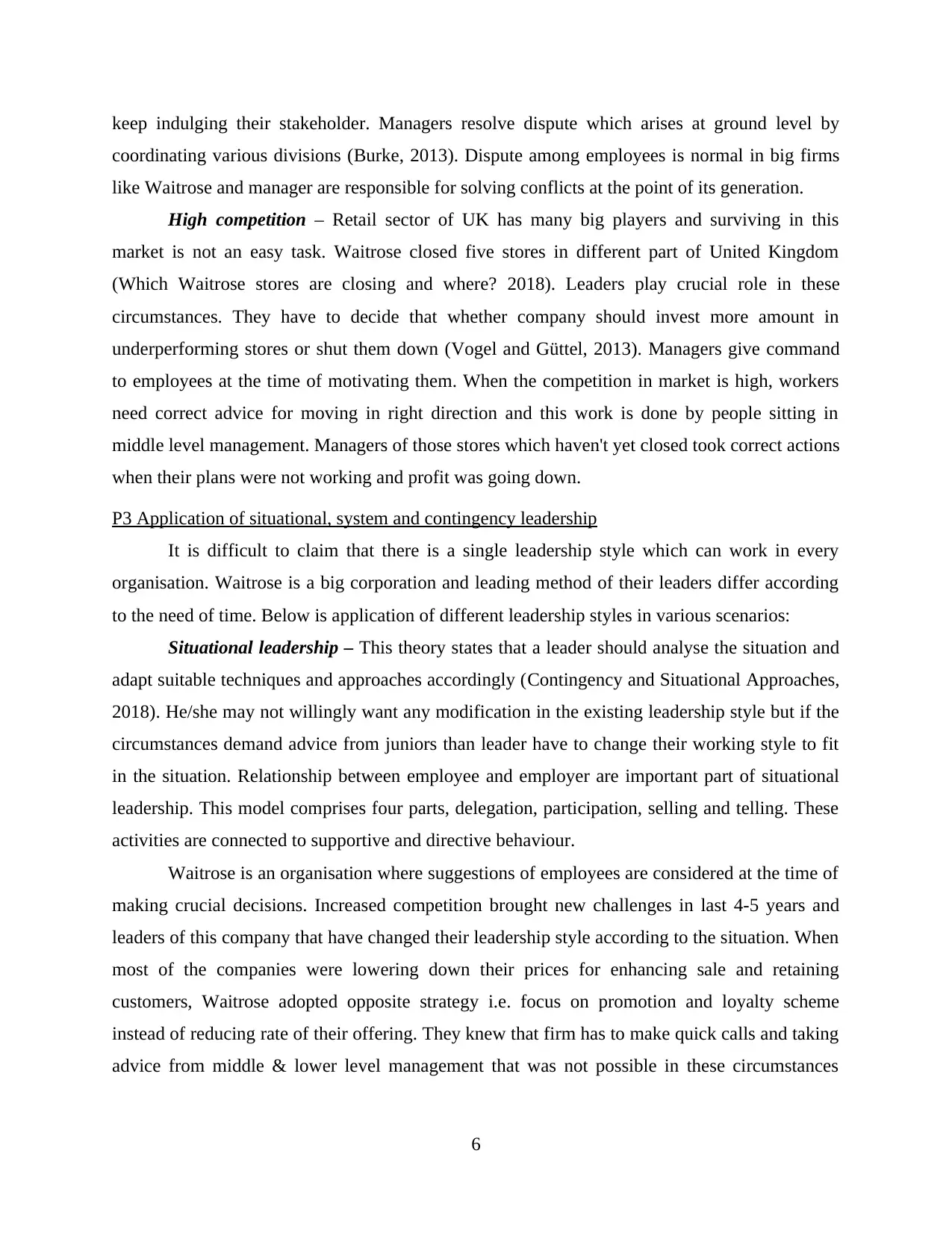
keep indulging their stakeholder. Managers resolve dispute which arises at ground level by
coordinating various divisions (Burke, 2013). Dispute among employees is normal in big firms
like Waitrose and manager are responsible for solving conflicts at the point of its generation.
High competition – Retail sector of UK has many big players and surviving in this
market is not an easy task. Waitrose closed five stores in different part of United Kingdom
(Which Waitrose stores are closing and where? 2018). Leaders play crucial role in these
circumstances. They have to decide that whether company should invest more amount in
underperforming stores or shut them down (Vogel and Güttel, 2013). Managers give command
to employees at the time of motivating them. When the competition in market is high, workers
need correct advice for moving in right direction and this work is done by people sitting in
middle level management. Managers of those stores which haven't yet closed took correct actions
when their plans were not working and profit was going down.
P3 Application of situational, system and contingency leadership
It is difficult to claim that there is a single leadership style which can work in every
organisation. Waitrose is a big corporation and leading method of their leaders differ according
to the need of time. Below is application of different leadership styles in various scenarios:
Situational leadership – This theory states that a leader should analyse the situation and
adapt suitable techniques and approaches accordingly (Contingency and Situational Approaches,
2018). He/she may not willingly want any modification in the existing leadership style but if the
circumstances demand advice from juniors than leader have to change their working style to fit
in the situation. Relationship between employee and employer are important part of situational
leadership. This model comprises four parts, delegation, participation, selling and telling. These
activities are connected to supportive and directive behaviour.
Waitrose is an organisation where suggestions of employees are considered at the time of
making crucial decisions. Increased competition brought new challenges in last 4-5 years and
leaders of this company that have changed their leadership style according to the situation. When
most of the companies were lowering down their prices for enhancing sale and retaining
customers, Waitrose adopted opposite strategy i.e. focus on promotion and loyalty scheme
instead of reducing rate of their offering. They knew that firm has to make quick calls and taking
advice from middle & lower level management that was not possible in these circumstances
6
coordinating various divisions (Burke, 2013). Dispute among employees is normal in big firms
like Waitrose and manager are responsible for solving conflicts at the point of its generation.
High competition – Retail sector of UK has many big players and surviving in this
market is not an easy task. Waitrose closed five stores in different part of United Kingdom
(Which Waitrose stores are closing and where? 2018). Leaders play crucial role in these
circumstances. They have to decide that whether company should invest more amount in
underperforming stores or shut them down (Vogel and Güttel, 2013). Managers give command
to employees at the time of motivating them. When the competition in market is high, workers
need correct advice for moving in right direction and this work is done by people sitting in
middle level management. Managers of those stores which haven't yet closed took correct actions
when their plans were not working and profit was going down.
P3 Application of situational, system and contingency leadership
It is difficult to claim that there is a single leadership style which can work in every
organisation. Waitrose is a big corporation and leading method of their leaders differ according
to the need of time. Below is application of different leadership styles in various scenarios:
Situational leadership – This theory states that a leader should analyse the situation and
adapt suitable techniques and approaches accordingly (Contingency and Situational Approaches,
2018). He/she may not willingly want any modification in the existing leadership style but if the
circumstances demand advice from juniors than leader have to change their working style to fit
in the situation. Relationship between employee and employer are important part of situational
leadership. This model comprises four parts, delegation, participation, selling and telling. These
activities are connected to supportive and directive behaviour.
Waitrose is an organisation where suggestions of employees are considered at the time of
making crucial decisions. Increased competition brought new challenges in last 4-5 years and
leaders of this company that have changed their leadership style according to the situation. When
most of the companies were lowering down their prices for enhancing sale and retaining
customers, Waitrose adopted opposite strategy i.e. focus on promotion and loyalty scheme
instead of reducing rate of their offering. They knew that firm has to make quick calls and taking
advice from middle & lower level management that was not possible in these circumstances
6
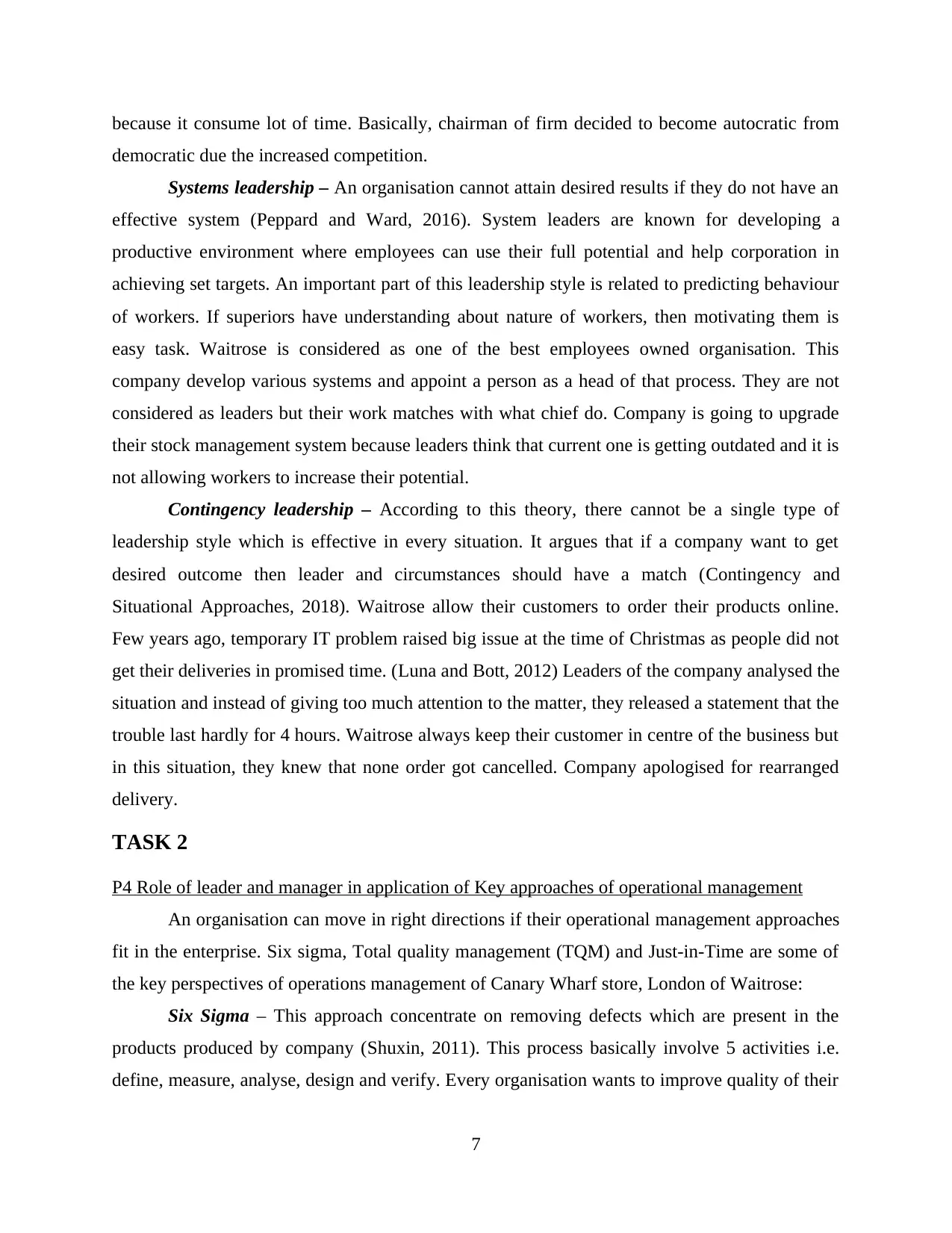
because it consume lot of time. Basically, chairman of firm decided to become autocratic from
democratic due the increased competition.
Systems leadership – An organisation cannot attain desired results if they do not have an
effective system (Peppard and Ward, 2016). System leaders are known for developing a
productive environment where employees can use their full potential and help corporation in
achieving set targets. An important part of this leadership style is related to predicting behaviour
of workers. If superiors have understanding about nature of workers, then motivating them is
easy task. Waitrose is considered as one of the best employees owned organisation. This
company develop various systems and appoint a person as a head of that process. They are not
considered as leaders but their work matches with what chief do. Company is going to upgrade
their stock management system because leaders think that current one is getting outdated and it is
not allowing workers to increase their potential.
Contingency leadership – According to this theory, there cannot be a single type of
leadership style which is effective in every situation. It argues that if a company want to get
desired outcome then leader and circumstances should have a match (Contingency and
Situational Approaches, 2018). Waitrose allow their customers to order their products online.
Few years ago, temporary IT problem raised big issue at the time of Christmas as people did not
get their deliveries in promised time. (Luna and Bott, 2012) Leaders of the company analysed the
situation and instead of giving too much attention to the matter, they released a statement that the
trouble last hardly for 4 hours. Waitrose always keep their customer in centre of the business but
in this situation, they knew that none order got cancelled. Company apologised for rearranged
delivery.
TASK 2
P4 Role of leader and manager in application of Key approaches of operational management
An organisation can move in right directions if their operational management approaches
fit in the enterprise. Six sigma, Total quality management (TQM) and Just-in-Time are some of
the key perspectives of operations management of Canary Wharf store, London of Waitrose:
Six Sigma – This approach concentrate on removing defects which are present in the
products produced by company (Shuxin, 2011). This process basically involve 5 activities i.e.
define, measure, analyse, design and verify. Every organisation wants to improve quality of their
7
democratic due the increased competition.
Systems leadership – An organisation cannot attain desired results if they do not have an
effective system (Peppard and Ward, 2016). System leaders are known for developing a
productive environment where employees can use their full potential and help corporation in
achieving set targets. An important part of this leadership style is related to predicting behaviour
of workers. If superiors have understanding about nature of workers, then motivating them is
easy task. Waitrose is considered as one of the best employees owned organisation. This
company develop various systems and appoint a person as a head of that process. They are not
considered as leaders but their work matches with what chief do. Company is going to upgrade
their stock management system because leaders think that current one is getting outdated and it is
not allowing workers to increase their potential.
Contingency leadership – According to this theory, there cannot be a single type of
leadership style which is effective in every situation. It argues that if a company want to get
desired outcome then leader and circumstances should have a match (Contingency and
Situational Approaches, 2018). Waitrose allow their customers to order their products online.
Few years ago, temporary IT problem raised big issue at the time of Christmas as people did not
get their deliveries in promised time. (Luna and Bott, 2012) Leaders of the company analysed the
situation and instead of giving too much attention to the matter, they released a statement that the
trouble last hardly for 4 hours. Waitrose always keep their customer in centre of the business but
in this situation, they knew that none order got cancelled. Company apologised for rearranged
delivery.
TASK 2
P4 Role of leader and manager in application of Key approaches of operational management
An organisation can move in right directions if their operational management approaches
fit in the enterprise. Six sigma, Total quality management (TQM) and Just-in-Time are some of
the key perspectives of operations management of Canary Wharf store, London of Waitrose:
Six Sigma – This approach concentrate on removing defects which are present in the
products produced by company (Shuxin, 2011). This process basically involve 5 activities i.e.
define, measure, analyse, design and verify. Every organisation wants to improve quality of their
7
⊘ This is a preview!⊘
Do you want full access?
Subscribe today to unlock all pages.

Trusted by 1+ million students worldwide
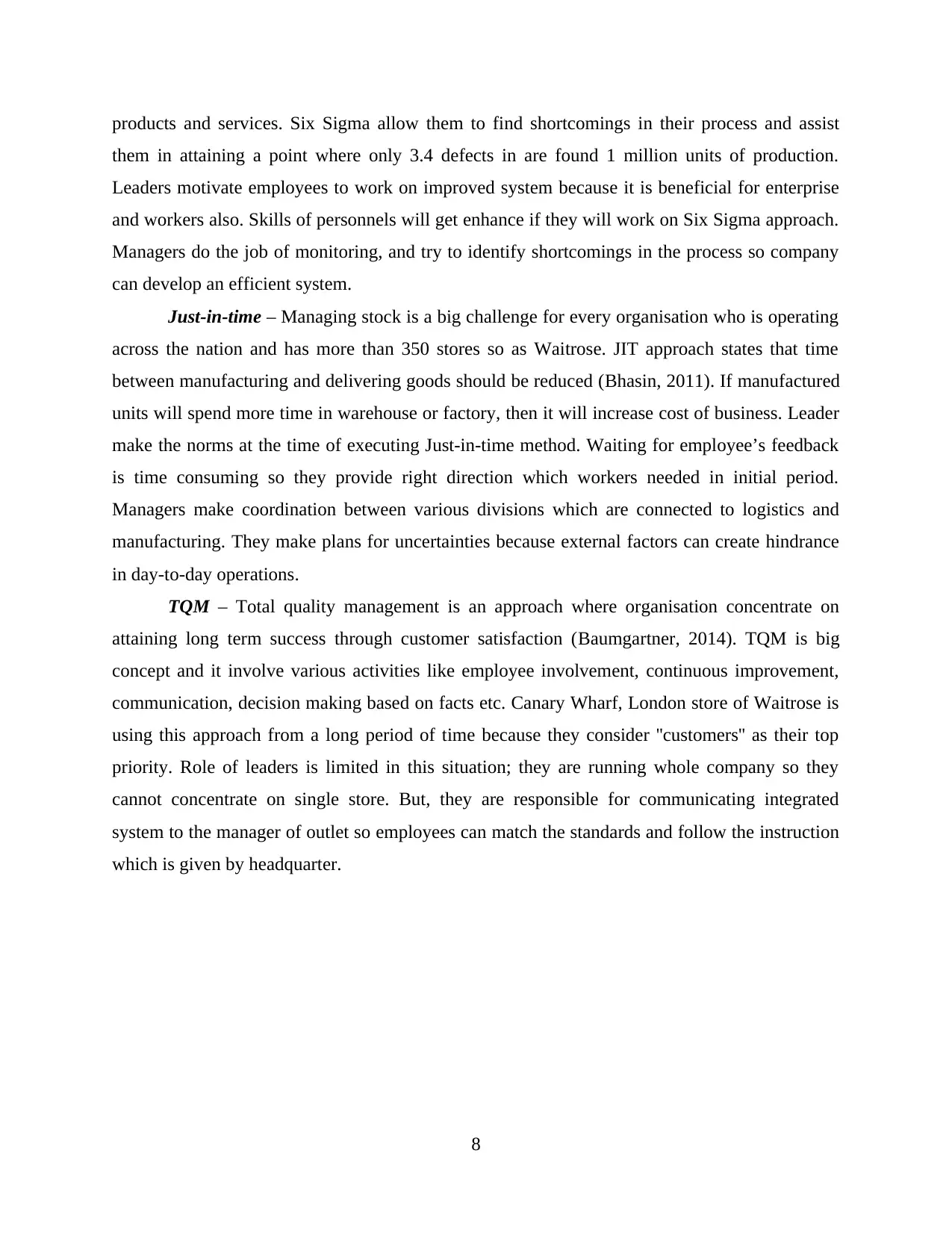
products and services. Six Sigma allow them to find shortcomings in their process and assist
them in attaining a point where only 3.4 defects in are found 1 million units of production.
Leaders motivate employees to work on improved system because it is beneficial for enterprise
and workers also. Skills of personnels will get enhance if they will work on Six Sigma approach.
Managers do the job of monitoring, and try to identify shortcomings in the process so company
can develop an efficient system.
Just-in-time – Managing stock is a big challenge for every organisation who is operating
across the nation and has more than 350 stores so as Waitrose. JIT approach states that time
between manufacturing and delivering goods should be reduced (Bhasin, 2011). If manufactured
units will spend more time in warehouse or factory, then it will increase cost of business. Leader
make the norms at the time of executing Just-in-time method. Waiting for employee’s feedback
is time consuming so they provide right direction which workers needed in initial period.
Managers make coordination between various divisions which are connected to logistics and
manufacturing. They make plans for uncertainties because external factors can create hindrance
in day-to-day operations.
TQM – Total quality management is an approach where organisation concentrate on
attaining long term success through customer satisfaction (Baumgartner, 2014). TQM is big
concept and it involve various activities like employee involvement, continuous improvement,
communication, decision making based on facts etc. Canary Wharf, London store of Waitrose is
using this approach from a long period of time because they consider ''customers'' as their top
priority. Role of leaders is limited in this situation; they are running whole company so they
cannot concentrate on single store. But, they are responsible for communicating integrated
system to the manager of outlet so employees can match the standards and follow the instruction
which is given by headquarter.
8
them in attaining a point where only 3.4 defects in are found 1 million units of production.
Leaders motivate employees to work on improved system because it is beneficial for enterprise
and workers also. Skills of personnels will get enhance if they will work on Six Sigma approach.
Managers do the job of monitoring, and try to identify shortcomings in the process so company
can develop an efficient system.
Just-in-time – Managing stock is a big challenge for every organisation who is operating
across the nation and has more than 350 stores so as Waitrose. JIT approach states that time
between manufacturing and delivering goods should be reduced (Bhasin, 2011). If manufactured
units will spend more time in warehouse or factory, then it will increase cost of business. Leader
make the norms at the time of executing Just-in-time method. Waiting for employee’s feedback
is time consuming so they provide right direction which workers needed in initial period.
Managers make coordination between various divisions which are connected to logistics and
manufacturing. They make plans for uncertainties because external factors can create hindrance
in day-to-day operations.
TQM – Total quality management is an approach where organisation concentrate on
attaining long term success through customer satisfaction (Baumgartner, 2014). TQM is big
concept and it involve various activities like employee involvement, continuous improvement,
communication, decision making based on facts etc. Canary Wharf, London store of Waitrose is
using this approach from a long period of time because they consider ''customers'' as their top
priority. Role of leaders is limited in this situation; they are running whole company so they
cannot concentrate on single store. But, they are responsible for communicating integrated
system to the manager of outlet so employees can match the standards and follow the instruction
which is given by headquarter.
8
Paraphrase This Document
Need a fresh take? Get an instant paraphrase of this document with our AI Paraphraser
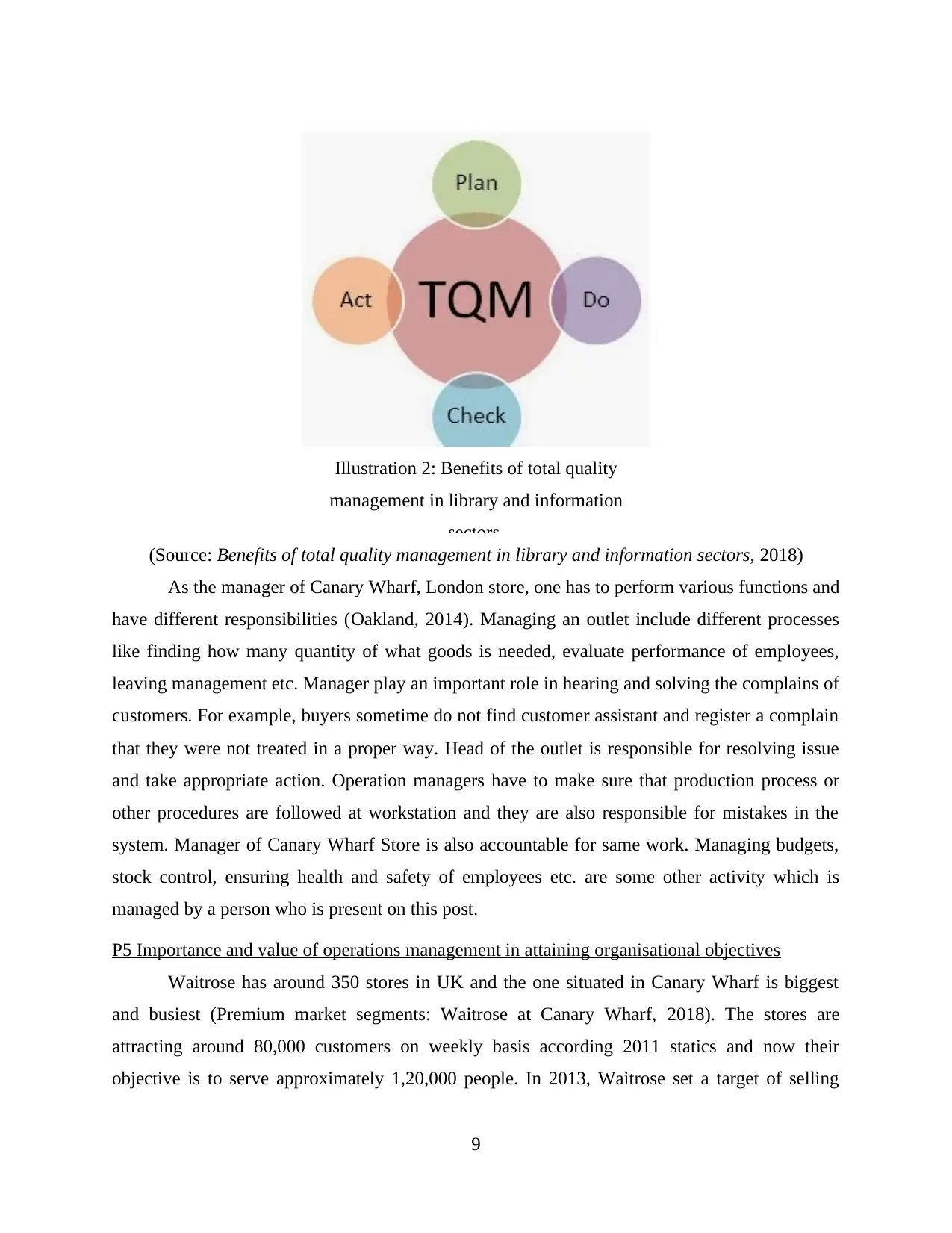
(Source: Benefits of total quality management in library and information sectors, 2018)
As the manager of Canary Wharf, London store, one has to perform various functions and
have different responsibilities (Oakland, 2014). Managing an outlet include different processes
like finding how many quantity of what goods is needed, evaluate performance of employees,
leaving management etc. Manager play an important role in hearing and solving the complains of
customers. For example, buyers sometime do not find customer assistant and register a complain
that they were not treated in a proper way. Head of the outlet is responsible for resolving issue
and take appropriate action. Operation managers have to make sure that production process or
other procedures are followed at workstation and they are also responsible for mistakes in the
system. Manager of Canary Wharf Store is also accountable for same work. Managing budgets,
stock control, ensuring health and safety of employees etc. are some other activity which is
managed by a person who is present on this post.
P5 Importance and value of operations management in attaining organisational objectives
Waitrose has around 350 stores in UK and the one situated in Canary Wharf is biggest
and busiest (Premium market segments: Waitrose at Canary Wharf, 2018). The stores are
attracting around 80,000 customers on weekly basis according 2011 statics and now their
objective is to serve approximately 1,20,000 people. In 2013, Waitrose set a target of selling
9
Illustration 2: Benefits of total quality
management in library and information
sectors.
As the manager of Canary Wharf, London store, one has to perform various functions and
have different responsibilities (Oakland, 2014). Managing an outlet include different processes
like finding how many quantity of what goods is needed, evaluate performance of employees,
leaving management etc. Manager play an important role in hearing and solving the complains of
customers. For example, buyers sometime do not find customer assistant and register a complain
that they were not treated in a proper way. Head of the outlet is responsible for resolving issue
and take appropriate action. Operation managers have to make sure that production process or
other procedures are followed at workstation and they are also responsible for mistakes in the
system. Manager of Canary Wharf Store is also accountable for same work. Managing budgets,
stock control, ensuring health and safety of employees etc. are some other activity which is
managed by a person who is present on this post.
P5 Importance and value of operations management in attaining organisational objectives
Waitrose has around 350 stores in UK and the one situated in Canary Wharf is biggest
and busiest (Premium market segments: Waitrose at Canary Wharf, 2018). The stores are
attracting around 80,000 customers on weekly basis according 2011 statics and now their
objective is to serve approximately 1,20,000 people. In 2013, Waitrose set a target of selling
9
Illustration 2: Benefits of total quality
management in library and information
sectors.
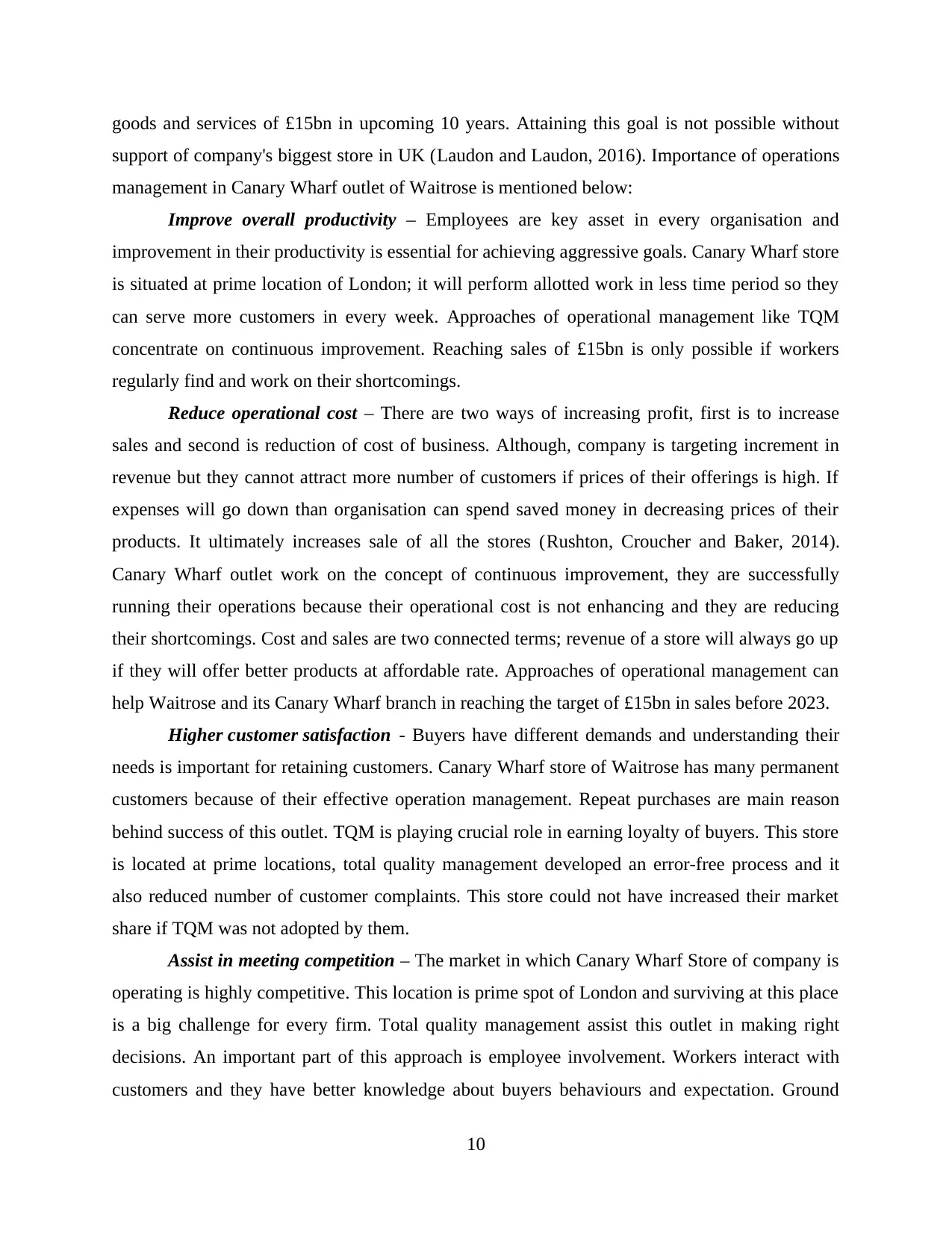
goods and services of £15bn in upcoming 10 years. Attaining this goal is not possible without
support of company's biggest store in UK (Laudon and Laudon, 2016). Importance of operations
management in Canary Wharf outlet of Waitrose is mentioned below:
Improve overall productivity – Employees are key asset in every organisation and
improvement in their productivity is essential for achieving aggressive goals. Canary Wharf store
is situated at prime location of London; it will perform allotted work in less time period so they
can serve more customers in every week. Approaches of operational management like TQM
concentrate on continuous improvement. Reaching sales of £15bn is only possible if workers
regularly find and work on their shortcomings.
Reduce operational cost – There are two ways of increasing profit, first is to increase
sales and second is reduction of cost of business. Although, company is targeting increment in
revenue but they cannot attract more number of customers if prices of their offerings is high. If
expenses will go down than organisation can spend saved money in decreasing prices of their
products. It ultimately increases sale of all the stores (Rushton, Croucher and Baker, 2014).
Canary Wharf outlet work on the concept of continuous improvement, they are successfully
running their operations because their operational cost is not enhancing and they are reducing
their shortcomings. Cost and sales are two connected terms; revenue of a store will always go up
if they will offer better products at affordable rate. Approaches of operational management can
help Waitrose and its Canary Wharf branch in reaching the target of £15bn in sales before 2023.
Higher customer satisfaction - Buyers have different demands and understanding their
needs is important for retaining customers. Canary Wharf store of Waitrose has many permanent
customers because of their effective operation management. Repeat purchases are main reason
behind success of this outlet. TQM is playing crucial role in earning loyalty of buyers. This store
is located at prime locations, total quality management developed an error-free process and it
also reduced number of customer complaints. This store could not have increased their market
share if TQM was not adopted by them.
Assist in meeting competition – The market in which Canary Wharf Store of company is
operating is highly competitive. This location is prime spot of London and surviving at this place
is a big challenge for every firm. Total quality management assist this outlet in making right
decisions. An important part of this approach is employee involvement. Workers interact with
customers and they have better knowledge about buyers behaviours and expectation. Ground
10
support of company's biggest store in UK (Laudon and Laudon, 2016). Importance of operations
management in Canary Wharf outlet of Waitrose is mentioned below:
Improve overall productivity – Employees are key asset in every organisation and
improvement in their productivity is essential for achieving aggressive goals. Canary Wharf store
is situated at prime location of London; it will perform allotted work in less time period so they
can serve more customers in every week. Approaches of operational management like TQM
concentrate on continuous improvement. Reaching sales of £15bn is only possible if workers
regularly find and work on their shortcomings.
Reduce operational cost – There are two ways of increasing profit, first is to increase
sales and second is reduction of cost of business. Although, company is targeting increment in
revenue but they cannot attract more number of customers if prices of their offerings is high. If
expenses will go down than organisation can spend saved money in decreasing prices of their
products. It ultimately increases sale of all the stores (Rushton, Croucher and Baker, 2014).
Canary Wharf outlet work on the concept of continuous improvement, they are successfully
running their operations because their operational cost is not enhancing and they are reducing
their shortcomings. Cost and sales are two connected terms; revenue of a store will always go up
if they will offer better products at affordable rate. Approaches of operational management can
help Waitrose and its Canary Wharf branch in reaching the target of £15bn in sales before 2023.
Higher customer satisfaction - Buyers have different demands and understanding their
needs is important for retaining customers. Canary Wharf store of Waitrose has many permanent
customers because of their effective operation management. Repeat purchases are main reason
behind success of this outlet. TQM is playing crucial role in earning loyalty of buyers. This store
is located at prime locations, total quality management developed an error-free process and it
also reduced number of customer complaints. This store could not have increased their market
share if TQM was not adopted by them.
Assist in meeting competition – The market in which Canary Wharf Store of company is
operating is highly competitive. This location is prime spot of London and surviving at this place
is a big challenge for every firm. Total quality management assist this outlet in making right
decisions. An important part of this approach is employee involvement. Workers interact with
customers and they have better knowledge about buyers behaviours and expectation. Ground
10
⊘ This is a preview!⊘
Do you want full access?
Subscribe today to unlock all pages.

Trusted by 1+ million students worldwide
1 out of 16
Related Documents
Your All-in-One AI-Powered Toolkit for Academic Success.
+13062052269
info@desklib.com
Available 24*7 on WhatsApp / Email
![[object Object]](/_next/static/media/star-bottom.7253800d.svg)
Unlock your academic potential
Copyright © 2020–2025 A2Z Services. All Rights Reserved. Developed and managed by ZUCOL.





